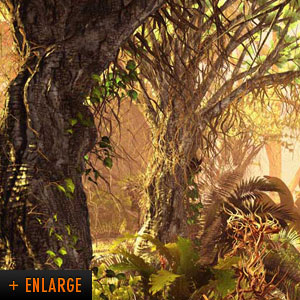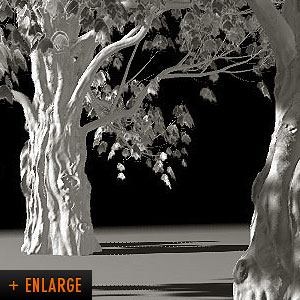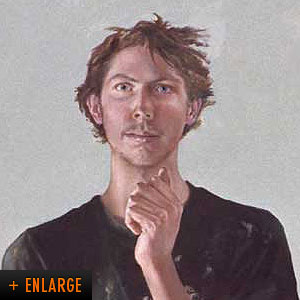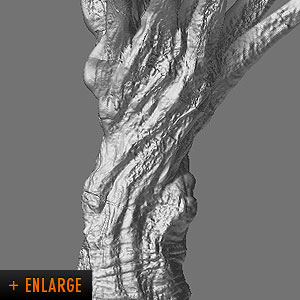
Ethan has developed a very interesting way of using ZBrush for his naturalistic settings which he has included in his series of DVDs from the Gnomon Workshop. This interview continues Pixologic's in-depth look at artists using ZBrush.
Tell us a little about yourself?
I am a human being living in Santa Cruz, California. I have one offspring and a mate. I also have a bicycle.
You have recently released some DVDs from The Gnomon Workshop using ZBrush in a very unique way. How did you first discover ZBrush?
One of the biggest problems with most 3D tree generators is that they don’t handle junctions between tree limbs very well. With ZBrush it is very easy to make limb junctions appear seamless. It can also to add an incredible amount of detail which can be saved as a displacement map or normal map to use back in the host 3d program. The use of ZBrush is not so unusual here, it's just that it's being used on trees rather than characters.
I've been watching ZBrush since version 1.2, and had a chance to work with version 1.5 for a spell. I was really impressed with the interactivity it offered. Then I saw some of the beta images prior to 2.0 being released and said "wow!" When I got a chance to use 2.0 I was hooked for good.
What lead you to using ZBrush with Maya's Paint Fx?
ZBrush and Paint Effects are very similar systems in many ways. With either program, it's intuitive and easy to create an astounding amount of detail quickly, and with both there is a non-standard interface that is a necessary byproduct of the programs abilities to handle extreme complexity.
Some time, a long time ago, I got sucked into the world of digital art in part because of the tantalizing possibilities the medium offered. But I've learned over and over again for the last fifteen years that what can be achieved in theory almost always gets cut short by the technicalities of software and hardware. Both ZBrush and, to a lesser extent, Paint Effects are great exceptions to this. With these tools, it really is possible to create interesting images more intuitively.

You have beautiful works called Poem for Frankenstein on your site. What is the motivation behind this?
Poem for Frankenstein started out as an animation about a courageous person I knew, but it's transformed over time. Now I wouldn't know how to explain it anymore, Basically, it includes a wagon piled high with wheels, insects, hummingbirds, various mechanical appendages and topped with 26 childlike heads. The wagon gets out of control and kills the neighbor, that is before it grows into an adult... For a Poem for Frankenstein I wanted to design a workflow where I could spend more time in a direct process of creation rather than problem solving. Combining painting, sculpture and 3D seemed a straightforward way to do it.
Since then I've added ZBrush to the mix since it has some nice tools for integrating 2d images into a 3d world - and is an intuitive tool in its own right. I started the project about 5 years ago, and like most people making independent shorts, I'm waiting for that big block of time to work on it- provided I have funding. With luck I'll get thrown in jail then have lots of time. This short combines real world media such as painting and sculpture into Maya's 3D environment. ZBrush will also play a big role. For as long as I have been involved with the digital arts I've had a love hate relationship with it. One of the main reasons I like it is for all the amazing potentials the digital arts offer, but the technical terrain to get what you want can be really treacherous. Unlike painting or sculpture, where the medium becomes like an extension of your body, digital art programs are constantly changing and tremendously complex. It sort of forces a mind-set like learning how to drive a stick shift and filling out IRS forms at the same time.
As an artist, how does CG art fit into your work? What is its role?
Digital arts and CG in particular are really seductive mediums. I got entranced a long time ago with the possibilities in CG and have kept with it in part out fascination, and in part to make a living. I've got to say, though, that even after all this time I'm still wary of 3D as an artistic medium, at least for me. Many artists find the meaning of their work through working on it. In contrast, 3D usually requires real preplanning. So the possibility for interesting "accidents" along the way gets largely screened out to begin with. ZBrush is one of the few 3D tools I've used that is fluid enough to generate interesting, usable and unexpected results.

In your work you do a lot of cg art and traditional art: painting and sculpting. How has ZBrush helped you combine your traditional interests with your cg interests?
I see ZBrush fulfilling a kind of niche between hands on mediums and digital art tools. Because ZBrush is SO interactive and able to create very high detail in real time, it almost feels like working in clay or paint. Some of the same kinds of intuitive thinking even come into play when I'm working in ZBrush as when working with my hands. This is actually ZBrush's best feature: A digital art tool that lets the user think in a similar, open ended way as when using paint or clay. This is a quality that's generally undervalued in most VFX tools but is really, really important to the individual artist.
As far as combining CG and traditional arts, ZBrush has some very interesting applications for integrating 2D work created outside the computer into the 3D world. Its ability to paint 3D form straight into 2D images, as well as deriving 3D form from 2D images are a few examples. Another method I'm eager to try is a method for creating depth maps based from photography and then use ZBrush to create and alter forms derived from the those maps.
How does ZBrush, in general, contribute to your artwork?
The more I use ZBrush, the more it lives at the front of my mind when I think of a project. So, in short, it contributes more and more as I use it. Definitely, whenever I consider how to create a 3D scene ZBrush is at the front of the list. It's become a sort of workflow hinge to me - linking 3D and 2D programs together and at the same time accentuating image quality overall. I know I sound like an ad but it's the best thing to come along since toothpaste.

You seem to have carved a very interesting path through the industry doing production work as well as designing some very cool projects. What has been the most important skill for you as an artist?
Yeah, it's definitely been interesting in a hit and miss sort of way. Being an artist in the effects industry can be a liability in that the most important thing for an artist to have is a strong internal vision. As most industry projects these days are large group endeavors conducted in more or less of an assembly line fashion, there are few spots for real creative work. Since it's mostly big entertainment money driving creative content, artists working on the VFX pipeline have to find some creativity within their job or make art on their own time or develop interesting vents for their frustrations.
The current primary 3D tool, Maya, really reflects the industry in a lot of ways. First, it's extremely complex and veritably impossible for a single person to learn inside and out. It's designed at heart as a group tool. So for artists wanting to do solo projects the choice is to devote a huge amount of time digesting Maya or turn to other tools which may have little or no use in the job market.
ZBrush is an interesting alternative - it's being used in the workplace and it's a great tool for individual artists to express with. In relation to this, it's also worth saying that creativity as a group process and creativity for the individual are really very different, and that much of the world's most enduring and mysterious art comes from the individual mind not group think. I believe when art is truly happening for a person they sort of lose themselves inside their work - and much of that experience is not really accessible to the type of group decision-making that occurs at a big production house.
"Any artist wanting to explore digital 3D
should learn ZBrush."
You mentioned Black Bird Tango on the phone. Can you tells us a little about it and how ZBrush is being used in it?
Black Bird Tango is another independent short that I've recently started working on again. It's in memory of a very interesting man I knew for many years - an engineer turned improv jazz musician who spent the last 27 years of his life obsessively redesigning the stand-up, string base. He lived a kind of incongruous existence as a paranoid, artistic, mad-man and inventor. The short features an intricate steam locomotive and a very detailed central character which will be created mostly in ZBrush. I also plan to use ZBrush as the primary texture tool for the whole project. I started this project 8 years ago and realized after a lot of modeling that there was no way to finish it as the technology just wasn't there for the character I wanted to make. ZBrush is one of the software inventions since that time that convinced me to work on this project again.
Any other comments about ZBrush you would like to share with us?
Any artist wanting to explore digital 3D should learn ZBrush.


